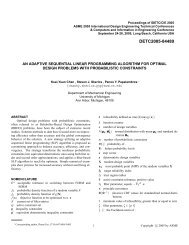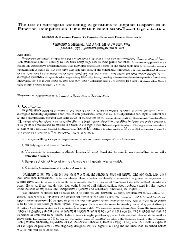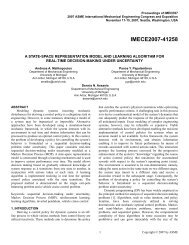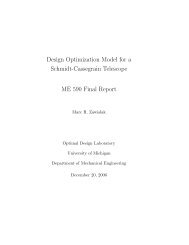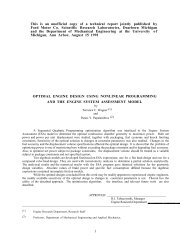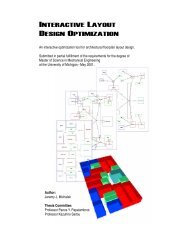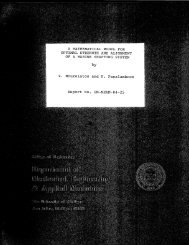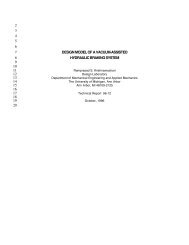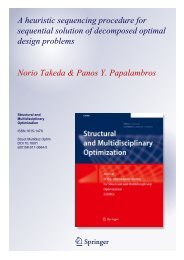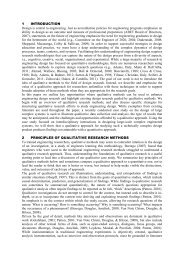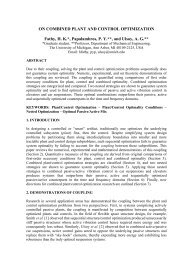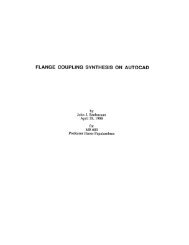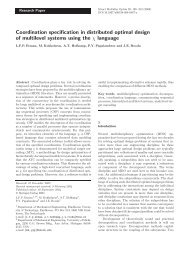Decomposition Analysis of an Automotive Powertrain Design ...
Decomposition Analysis of an Automotive Powertrain Design ...
Decomposition Analysis of an Automotive Powertrain Design ...
You also want an ePaper? Increase the reach of your titles
YUMPU automatically turns print PDFs into web optimized ePapers that Google loves.
educes fuel flow by 1.3%; the constraint on peak power, the constraint on compression ratio, <strong>an</strong>d<br />
the constraint on burn duration are active. The combustion stability constraint limited the egr factor<br />
to 1.37. The ch<strong>an</strong>ge in egr <strong>an</strong>d the ch<strong>an</strong>ge in bore-stroke ratio (from 1.11 to 1.04) both result in<br />
better thermal efficiency <strong>an</strong>d lower fuel flow. The bore-stroke ratio could ch<strong>an</strong>ge because <strong>of</strong> the<br />
latitude in the peak power constraint which was the result <strong>of</strong> <strong>an</strong> improved m<strong>an</strong>ifold. The improved<br />
volumetric efficiency allowed this ch<strong>an</strong>ge.<br />
The first solution to SP was then used to generate a new fuel, emissions, <strong>an</strong>d torque curve<br />
to solve the MP. The results <strong>of</strong> this optimization are shown in columns VIII <strong>an</strong>d IX <strong>of</strong> Table I. In<br />
this iteration small ch<strong>an</strong>ges were observed in the gear ratios, but the engine was downsized by 5%<br />
effecting <strong>an</strong>other 2% in fuel economy improvement. Again, the 0-60 constraint became active. In<br />
this iteration, fuel economy was improved at the expense <strong>of</strong> 0-60 time until the 0-60 constraint<br />
became active. Note the reduction in stall speed from 2728 to 2655 caused by the reduced torque<br />
from engine down-sizing. Also, NOx is reduced 15%, the 5-20 time is virtually the same, <strong>an</strong>d<br />
only 3 mph has been sacrificed in cruising gradeability velocity compared to the original baseline.<br />
A second set <strong>of</strong> optimal torque-speed points were generated to solve the second iteration <strong>of</strong><br />
SP (column X). In this iteration no improvement in the objective was obtained.<br />
Not a surprising<br />
result, since the starting point is at the peak power constraint boundary, <strong>an</strong>d ch<strong>an</strong>ges in bore-stroke<br />
only improve the power at the expense <strong>of</strong> fuel. Similarly, the starting point is on the burn rate<br />
boundary, <strong>an</strong>d egr will improve fuel only at the expense <strong>of</strong> burn rate.<br />
Figure 12 summarizes the iteration history <strong>of</strong> the master problem, <strong>an</strong>d illustrates the fuel<br />
economy/perform<strong>an</strong>ce trade<strong>of</strong>f as a function <strong>of</strong> engine displacement. In both iterations the 0-60<br />
starts feasible, <strong>an</strong>d the engine is downsized until the 0-60 constraint is active. The improvement in<br />
volumetric efficiency by varying the m<strong>an</strong>ifold geometry allowed <strong>an</strong> additional 5% reduction in<br />
engine displacement which resulted in <strong>an</strong> additional 2% improvement in metro-highway fuel



